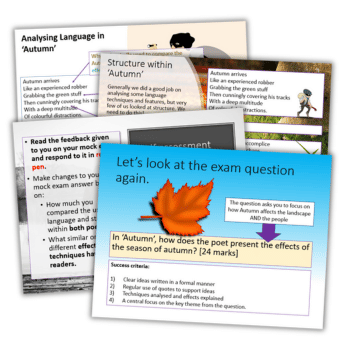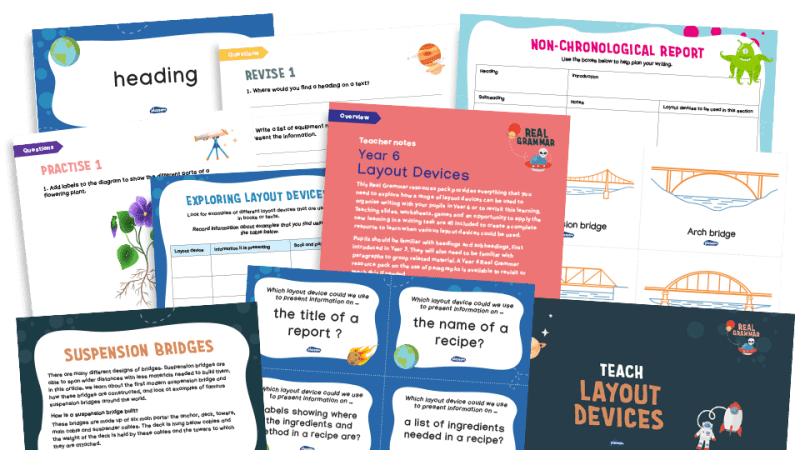6 ways to improve students’ unseen poetry analysis

Get students writing poetry, says Kate Clanchy, and they’ll soon develop the skills they need to analyse and interpret other poets’ work…

- by Kate Clanchy

Unseen poetry is scary because – well, because it’s unseen. Anything might happen. Your dead-cert 9 student could get the wrong end of the stick and throw it all away. Your carefully coached borderline kids could easily panic, write a load of vague nonsense and drop to a 3.
It’s tempting, especially in the current educational climate, to arm them all with a carefully learnt vocabulary kit; and to have the whole class chanting ‘synecdoche’ and Remember How You Told His Mum (acronym for rhythm – I actually recommend this one!) outside the exam hall before they go in.
The thing is, this may be counterproductive. The real hazard of unseen poetry isn’t forgetting a label, because in fact you can describe most literary features using the words ‘image’ ‘sound’ and ‘suggests’ if you need to.
Much bigger mistakes come from forgetting common sense and producing an interpretation which has only the most tangential bearing on the words of the poem.
When they think the Lady of Shalott is about a recipe for onion soup.
When they invent a character who is not in the poem, or insist on a nonsensical reason for a rhyme.
When you look at the poem, and the interpretation, all bedecked with labels as it might be, and cannot see where they mesh at all.
To avoid this – to build confident, nonsense-proof, individual readers of poetry, even among your weakest candidates, and also to have more fun in your classroom – I’d recommend writing poetry regularly.
This may take time, but never wastes it.
A student who writes poems themselves is much more likely to go into an exam with confidence, and they’ll be nonsense proof, because they know that a poem is a series of images which is trying to communicate with an audience – they’ll know it from the inside out.
I’m aware this is a little counter cultural, but I can promise you that in the school I‘ve taught in for the last decade we have all written poetry constantly and our GCSE marks, especially at the top and at the borderline, are outstanding – with our highest grades consistently coming for unseen poetry.
These are the sorts of things we do…
1 | Start in KS3
KS3 is actually much less bedevilled with curriculum details than it has been for a couple of decades.
Don’t waste time starting on GCSE-style essays – get in there and teach them what an image is. I play The Surrealist’s Game; instructions can be found here.
2 | Imitate and echo
The most natural thing to do when you’ve finished reading a poem is to write a few lines in the same rhythm and style.
Try it with your class. You may be surprised to find that the strongest versions come from your less academic students – the ones from an EAL background, or who are dyslexic.
It’s because they are listening to the sounds harder.
If you can point out that a student is using rhythm in her own writing, she is much more likely to give an unseen poet credit for doing the same thing.
You can go further and write full length replies and versions of poems. This isn’t plagiarism. If you do it regularly – read a poem, write a poem in response – you will find the students write more and more independently and that their poems are as diverse as their lives.
For instance, try giving everyone in your Year 10 classes a go at the Where I am From Project. This encourages you all to write a poem using the frame ‘I come from’, and there is a good web resource, plus a very glam video here:
It’s a miraculous formula. Every student in your class will produce something about their lives using that rhythm.
Many will remember it’s called dactylic. They might even recall that in an exam. But they will certainly keep the understanding that a poem is for telling people about yourself – for communicating.
3 | Interact on-screen
Computer screens are the best poets’ tools ever – get in the habit of pushing poems around on them as you write. Be mean about your editing though; English teachers are often much too kind about creative effusions.
Ruthlessly cut extra adjectives. Ban the word ‘very’. Make the student cut their poem by 20% on the word count, and make them do the same to their neighbours.
Celebrate too – tweet your poems, print them, put an ‘image of the week’ on the wall, make a giant poster, run a blog, publish a book.
Do the same sort of thing with published and syllabus poems. Put them on a screen with gaps to close, or with all the line breaks taken out, and get the students to put them back in.
Copy the words at the ends of the lines down the screen and ask the students to write a new poem using them – this is called a golden shovel.
Make the poems into film scripts, into posters, or videos. Help your students to see that published poets are writers making choices, just like they are – it’s a powerful way into writing critically about those choices.
4 | Write forms
It is actually easier to write an iambic couplet than it is to define it, and probably a quicker way to remember the term as well. The same goes for ballad metre – and it’s a lot of fun to write in.
Other forms are a little more complex, but well worth having a go at, for once you have written a sonnet you will never, ever forget that there must be 14 lines with a couplet.
If you have written an Italian sonnet you will have a volta engraved on your forehead – and you will always look, with the sort of anxious envy that you display when viewing rival teams’ scores, at what another poet has done with it.
Try writing a sonnet-like thing if the line counting gets too much – twelve unrhymed lines and a couplet; six lines, a turn, then eight lines.
5 | Write yourself
I’m a great believer in getting teachers to write themselves. We give away our creativity to our students every day, and need replenishing and nourishing.
Write yourself in class, find a group to join, write in response to things you read and see.
Remember that you are entitled to write, just as your students are – and if you can believe that, you will help them believe that, too.
6 | Think long-term
In English teaching, we do a lot of stranding – WALTs and LOs – and sometimes it’s hard to fit creative writing into those. Remember that a good poem is much richer and more complex than any WALT, and so are the lessons of learning to write it.
If you teach students to be confident, entitled writers of poetry they will over time acquire the skills to write about unseen poetry in GCSE papers. They, and you, will also have more joy in your classroom.
Kate Clanchy is a prize-winning poet, playwright and teacher, as well as being the Forward Arts Foundation official Education Advisor. She was awarded an MBE for services to literature in 2018. Find more resources for National Poetry Day.










